Introduction
In the dynamic landscape of modern business, the quest for operational efficiency has never been more critical. As organizations increasingly turn to Robotic Process Automation (RPA) to streamline their processes, the choice of tools becomes paramount. With options like EMMA RPA and Microsoft Power Automate leading the charge, understanding their unique functionalities and benefits can empower companies to make informed decisions that align with their strategic goals.
This article delves into the strategies for enhancing productivity, integrating RPA with existing systems, and measuring performance, while also addressing common challenges that may arise during implementation. By leveraging these insights, organizations can harness the full potential of RPA, driving efficiency and fostering a culture of innovation that ultimately elevates employee satisfaction and operational success.
Choosing the Right RPA Tools for Cloud Efficiency
In the pursuit of cloud efficiency, organizations must carefully evaluate cloud RPA tools, specifically EMMA RPA and Microsoft Power Automate, both recognized for their robust functionality and user-friendly interfaces. EMMA RPA transforms operational efficiency by addressing outdated systems and task repetition fatigue, while also tackling staffing shortages, thereby enhancing employee morale through intelligent processes. Its seamless digitalization features render it user-friendly for various applications, ultimately enhancing productivity in the workplace.
Power Automate is recognized as Microsoft’s leading solution for advanced business workflow management. It enables entities to craft dynamic automated workflows that seamlessly connect applications and services, streamlining operations and enhancing overall efficiency. Recent case studies demonstrate significant improvements, such as a mid-sized company in the healthcare sector reducing data entry errors by 70% and accelerating software testing processes by 50% through GUI technology, highlighting the measurable outcomes of these technologies in improving service delivery.
The decision on which RPA tool to adopt ultimately hinges on specific organizational goals and the complexity of tasks intended for mechanization, particularly when considering cloud RPA options. A thorough evaluation of these options—including trial periods, feature comparisons, and user feedback—will yield valuable insights that align with the entity’s efficiency objectives. Recent statistics indicate that RPA technologies are expected to grow at a CAGR of 27.02% from 2023 to 2030, emphasizing the market potential and relevance of RPA tools.
Additionally, 74% of automation tool users report increased task completion speeds, underscoring the importance of selecting the right RPA solution. By leveraging such data and insights, entities can make informed decisions that enhance operational efficiency and employee satisfaction.
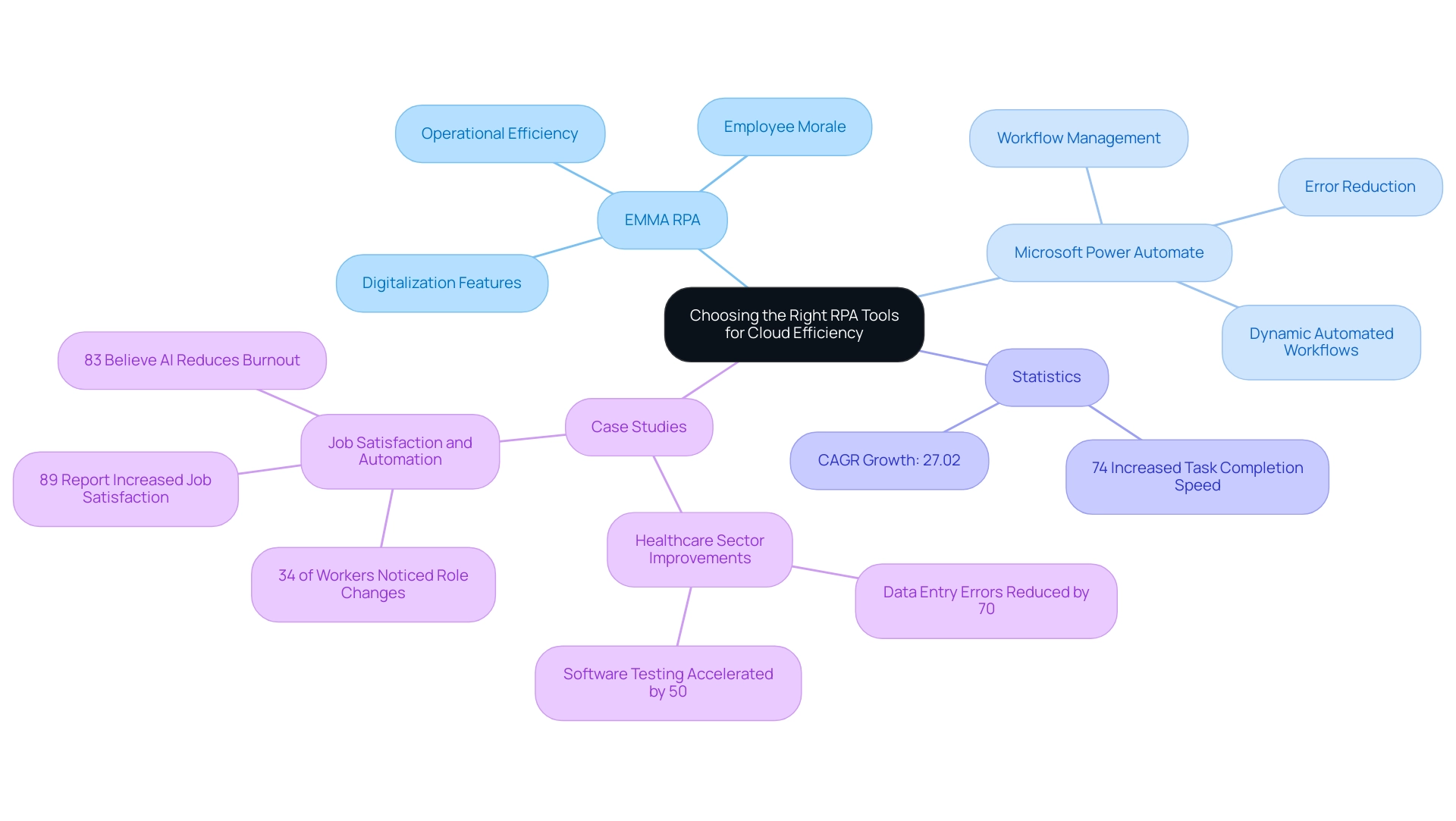
Strategies for Enhancing Productivity with Cloud RPA
To significantly enhance productivity through cloud RPA, organizations should adopt the following strategies:
- Identify High-Impact Processes:
Begin by conducting a thorough analysis of existing workflows to target repetitive and time-intensive tasks that stand to benefit from automation. Prioritize processes that necessitate high accuracy and are particularly vulnerable to human error, such as data entry and invoice processing.
Given that only 3% of entities have successfully scaled their digital workforce, identifying these high-impact areas is crucial for effective RPA implementation.
-
Establish Clear Objectives:
It is essential to define specific, measurable goals for RPA implementation that resonate with broader business objectives. For example, if the goal is to reduce operational costs, quantify the anticipated savings and outline a realistic timeframe for achieving these results. -
Train and Empower Employees:
Involve employees throughout the digitization journey by offering comprehensive training on the new RPA tools. Enabling team members to comprehend and adopt technological advancements nurtures a culture of innovation and improves acceptance throughout the company. As the Deloitte Global RPA Survey shows, over 90% of C-level executives employing intelligent processes believe their companies excel at managing change in response to evolving business trends, highlighting the importance of aligning RPA efforts with business objectives and addressing workplace challenges.
Additionally, addressing the exhaustion and annoyance caused by repetitive tasks can improve morale and productivity.
- Implement Continuous Monitoring and Improvement:
After deploying RPA, it is crucial to establish key metrics to assess its impact on productivity. Consistently assessing performance data can reveal areas for additional optimization, enabling organizations to adjust their strategies as needed.
A case study on productivity gains from mechanization reveals that 79% of workers identified increased productivity as a primary benefit, underscoring the value of continuous monitoring.
- Encourage Cross-Departmental Collaboration:
Promote open communication between departments to ensure that mechanization initiatives are aligned with comprehensive business processes. Collaborative efforts can uncover new automation opportunities and facilitate the sharing of best practices among teams.
This collaboration can also help address challenges related to attracting and retaining talent, as a more efficient workflow can make operational roles more appealing.
By embracing these strategies, companies can significantly enhance their cloud RPA initiatives, which drive the desired productivity gains that contribute to improved operational efficiency and a greater focus on strategic, high-value tasks. In today’s rapidly evolving AI landscape, overcoming technology implementation challenges is essential for maintaining a competitive edge and ensuring that your enterprise thrives.
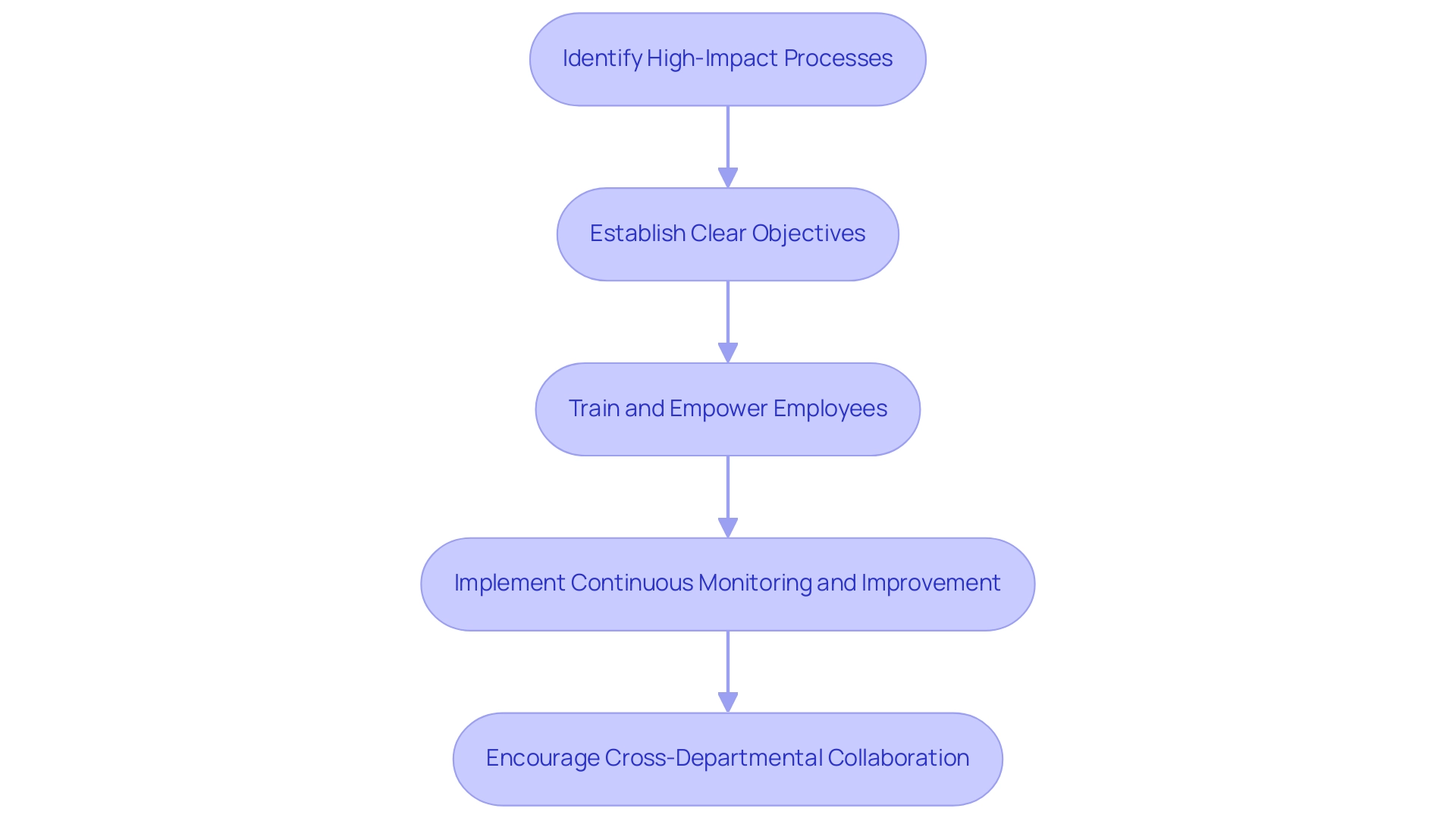
Integrating RPA with Existing Business Systems
To successfully integrate cloud RPA with existing business systems, organizations should adhere to the following best practices:
-
Conduct a System Audit:
Begin with a comprehensive assessment of current business systems to pinpoint potential integration points. Understanding data flows and system capabilities clarifies how RPA will interact with existing technologies, setting the stage for effective implementation and enhancing operational efficiency. -
Ensure Compatibility:
Selecting RPA tools that align with existing software and platforms is crucial. This compatibility facilitates seamless data sharing and automation, thus minimizing operational disruptions and enhancing overall efficiency in the rapidly evolving AI landscape. -
Leverage APIs and Connectors:
Utilize Application Programming Interfaces (APIs) and pre-built connectors that enable efficient communication between RPA tools and current systems. This strategy not only accelerates the implementation but also reduces complexity, making integration more manageable and fostering improved productivity. -
Pilot Integrations:
Initiate pilot projects to trial integrations before committing to a full-scale rollout. This step enables entities to recognize and tackle potential issues early, ensuring a smoother and more successful integration experience while minimizing risks related to technology implementation challenges. -
Continuously Monitor Integration Performance:
Post-integration, it is essential to continuously monitor the performance of automated processes. Regular evaluations can highlight areas for improvement, enabling entities to fine-tune their integrations and enhance efficiency over time, thus unlocking the full potential of Business Intelligence and RPA.
By prioritizing these best practices, entities can effectively integrate their existing technology stacks with cloud RPA tools. Such strategic integration not only streamlines operations but also fosters enhanced productivity—a necessity in today’s competitive landscape. Notably, a staggering 78 percent of entities adopting RPA anticipate significant increases in their RPA investments within the next three years, underscoring the critical need for successful implementations.
Additionally, RPA is capable of handling up to 90% of data entry tasks in clinical research, illustrating its transformative potential in driving data-driven insights and operational efficiency. Successful collaborations with experts can enable robust RPA strategies while ensuring IT security, empowering entities to adapt to these technologies and thrive in their operational goals.
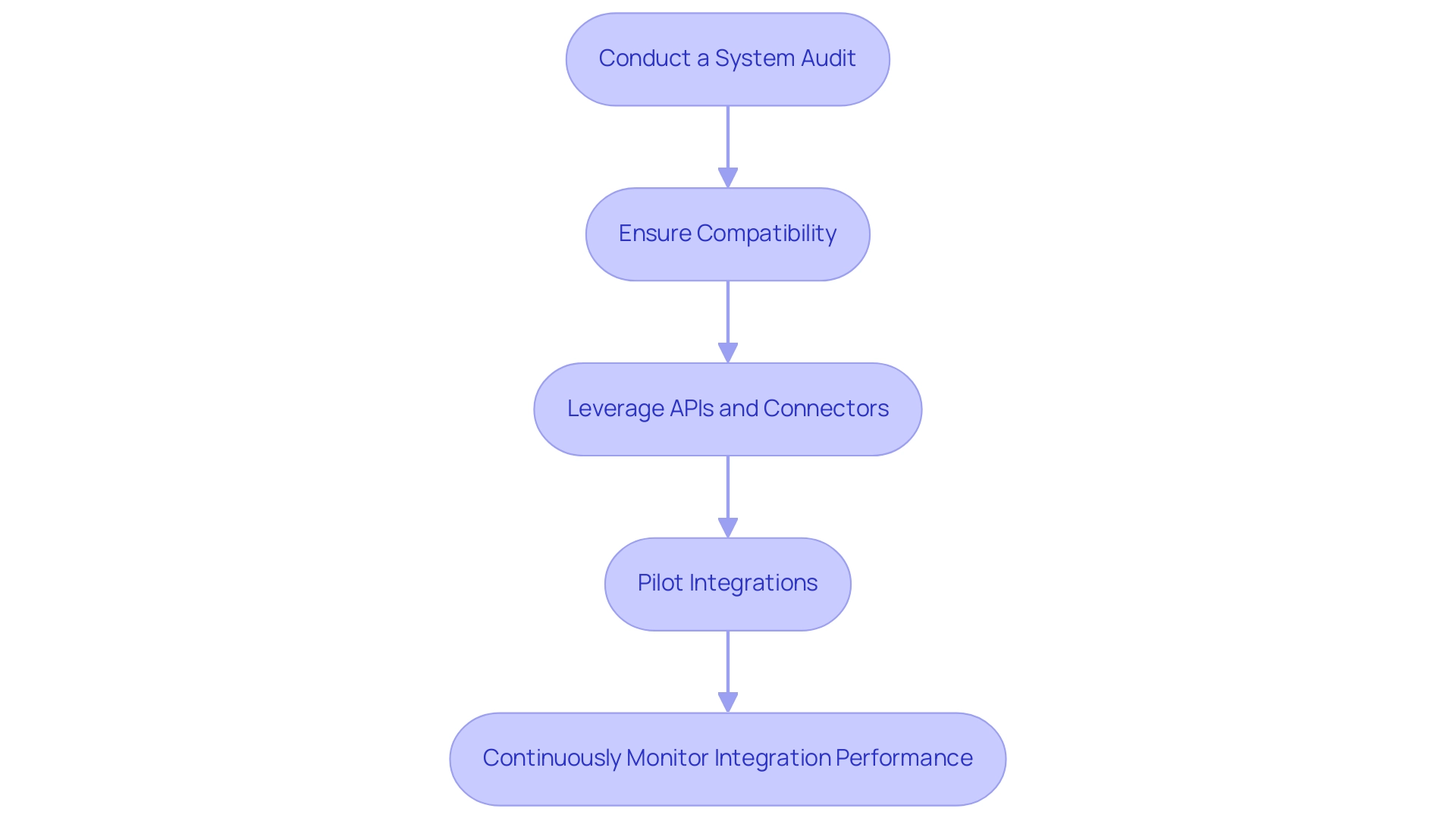
Measuring and Analyzing RPA Performance
To effectively measure and analyze the performance of Robotic Process Automation (RPA), organizations should concentrate on key performance indicators (KPIs) that provide actionable insights:
-
Time Savings: By calculating the time saved through mechanization, organizations can quantify the enhancement in operational efficiency. On average, workers save 3.6 hours per week thanks to mechanization, significantly boosting productivity and allowing teams to focus on higher-value tasks.
-
Error Reduction: Monitoring the reduction in errors in automated processes compared to manual execution is crucial. A substantial decrease in errors not only signifies successful mechanization but also enhances reliability in operations, fostering a culture of accuracy.
-
Cost Savings: Evaluating the financial implications of RPA implementation, including reduced labor costs and boosted productivity, is essential. Comprehending the return on investment (ROI) supports the continuation and expansion of automated initiatives, with numerous entities acknowledging the advantages of usage-based pricing. Notably, a recent Robocorp survey revealed that 65% of respondents acknowledged the potential advantages of such pricing models.
-
Throughput: Measuring the volume of transactions or activities completed over a designated timeframe provides insights into the scalability of RPA solutions. This metric is essential for evaluating how effectively automated systems can manage heightened workloads, guaranteeing that organizations can expand without being obstructed by manual tasks.
-
Employee Satisfaction: Gathering feedback from employees about their experiences with automated systems can reveal the impact of RPA on job satisfaction. Employees who are freed from routine tasks often demonstrate higher levels of engagement, which is a strong indicator of successful mechanization.
Additionally, integrating tailored AI solutions with RPA can further enhance operational efficiency by addressing specific business challenges and optimizing workflows. These AI technologies can analyze data patterns and provide insights that complement RPA initiatives, leading to more informed decision-making.
It’s important to note that successful business process optimization requires team involvement, with 45% of business teams playing critical roles. Consistently evaluating these KPIs allows organizations to make informed, data-driven choices to enhance their cloud RPA strategies, ensuring that processes continue to provide value and align seamlessly with their overarching business objectives.
The case study titled ‘User Satisfaction and Customer Experience‘ illustrates the effect of RPA on customer service and employee routines, showcasing enhanced speed and accuracy of responses due to the mechanization of repetitive tasks. As Yana Pokora, a Content Manager and RPA researcher, emphasizes, the successful implementation of automation necessitates ongoing evaluation to enhance both customer experience and employee efficiency, reinforcing the importance of these KPIs. Moreover, leveraging Business Intelligence to transform raw data into actionable insights can empower entities to make strategic decisions that drive growth and innovation.
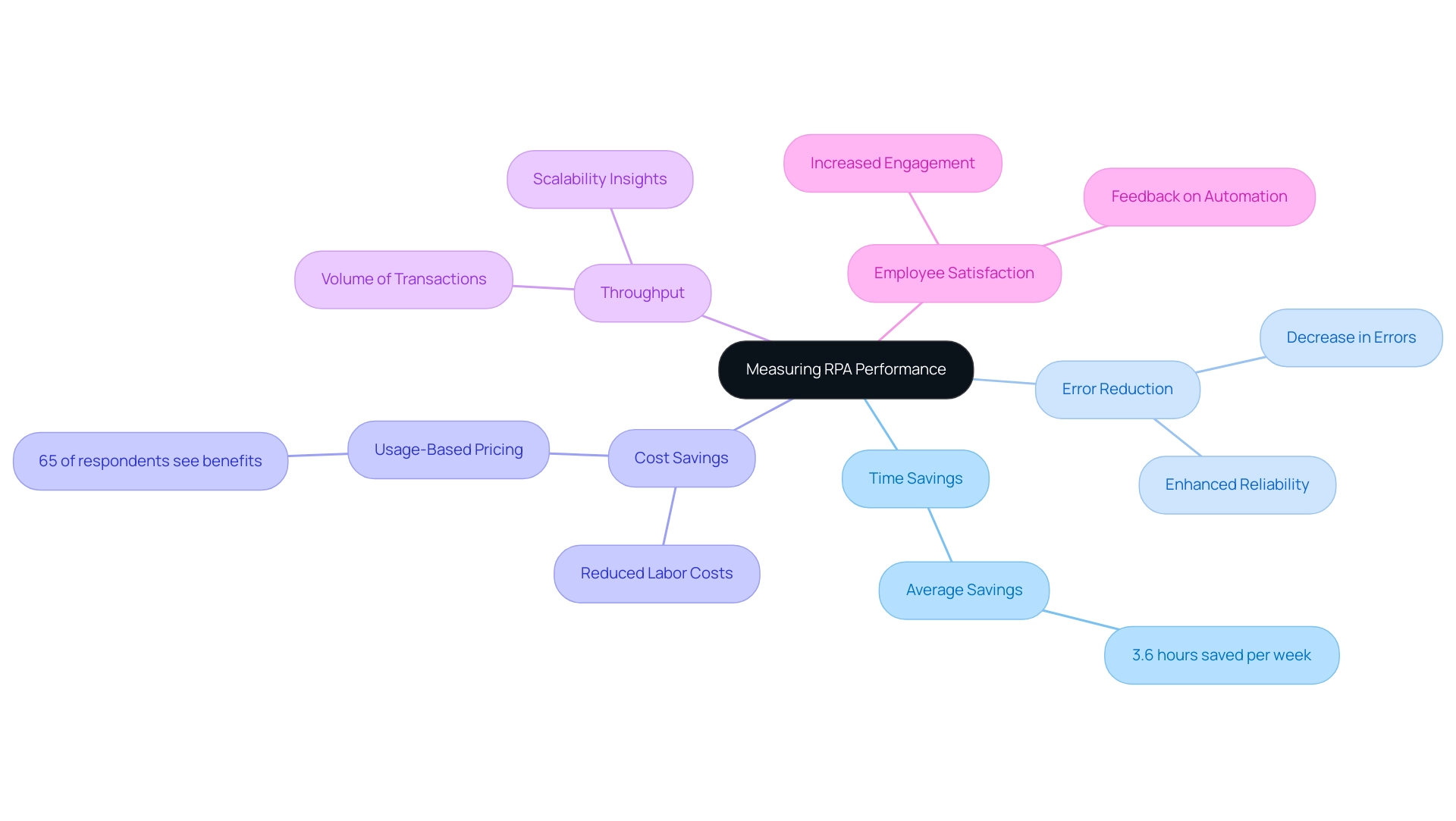
Overcoming Common Challenges in RPA Implementation
Successfully implementing cloud RPA requires a strategic approach to effectively navigate common challenges. Here are several key strategies to consider:
-
Communicate the Benefits: Clearly articulate the advantages of RPA to all stakeholders.
Highlighting time savings, reduced errors, lower costs, and enhanced job satisfaction can facilitate buy-in from employees and management alike. -
Involve Employees Early: Engage employees in the RPA implementation process from the outset.
By including them in discussions and decision-making, organizations can significantly reduce resistance and foster a culture of acceptance. -
Provide Comprehensive Training: Implement thorough training programs to ensure employees feel confident using new RPA tools.
Addressing potential concerns and emphasizing how mechanization will enhance their roles is crucial for smooth adoption. -
Start Small and Scale Gradually: Initiate RPA projects with smaller, manageable tasks that require minimal disruption.
As initial successes are achieved, gradually expand initiatives to encompass larger processes, reinforcing confidence in RPA’s effectiveness. -
Establish a Change Management Plan: Create a structured change management strategy that includes ongoing support and resources for employees.
By proactively addressing concerns and providing assistance during the transition, entities can ease the implementation process. -
Integrate with Other Technologies: Successful RPA implementations frequently connect with other technologies, such as AI and Business Intelligence, to develop more intelligent and adaptable systems, enhancing the overall effectiveness of initiatives.
These strategies are essential for cultivating a supportive environment for RPA adoption. By tackling these challenges directly, organizations can attain successful results, ultimately resulting in improved operational efficiency and greater employee satisfaction.
In fact, a recent study found that 91% of employees believe that technology saves time and enhances work-life balance, with 89% reporting increased job satisfaction as a result of these advancements.
Furthermore, with 80% of health systems planning to invest in digital healthcare solutions over the next five years, the urgency for RPA adoption is clear. Cloud RPA not only streamlines processes but also positively contributes to employee morale, making it a vital component of modern operational strategies.
As Yana Pokora, Content Manager at Flobotics, stated, ‘We hope this list of RPA stats has convinced you that automation is the next step you should take to improve the all-round efficiency of your business.
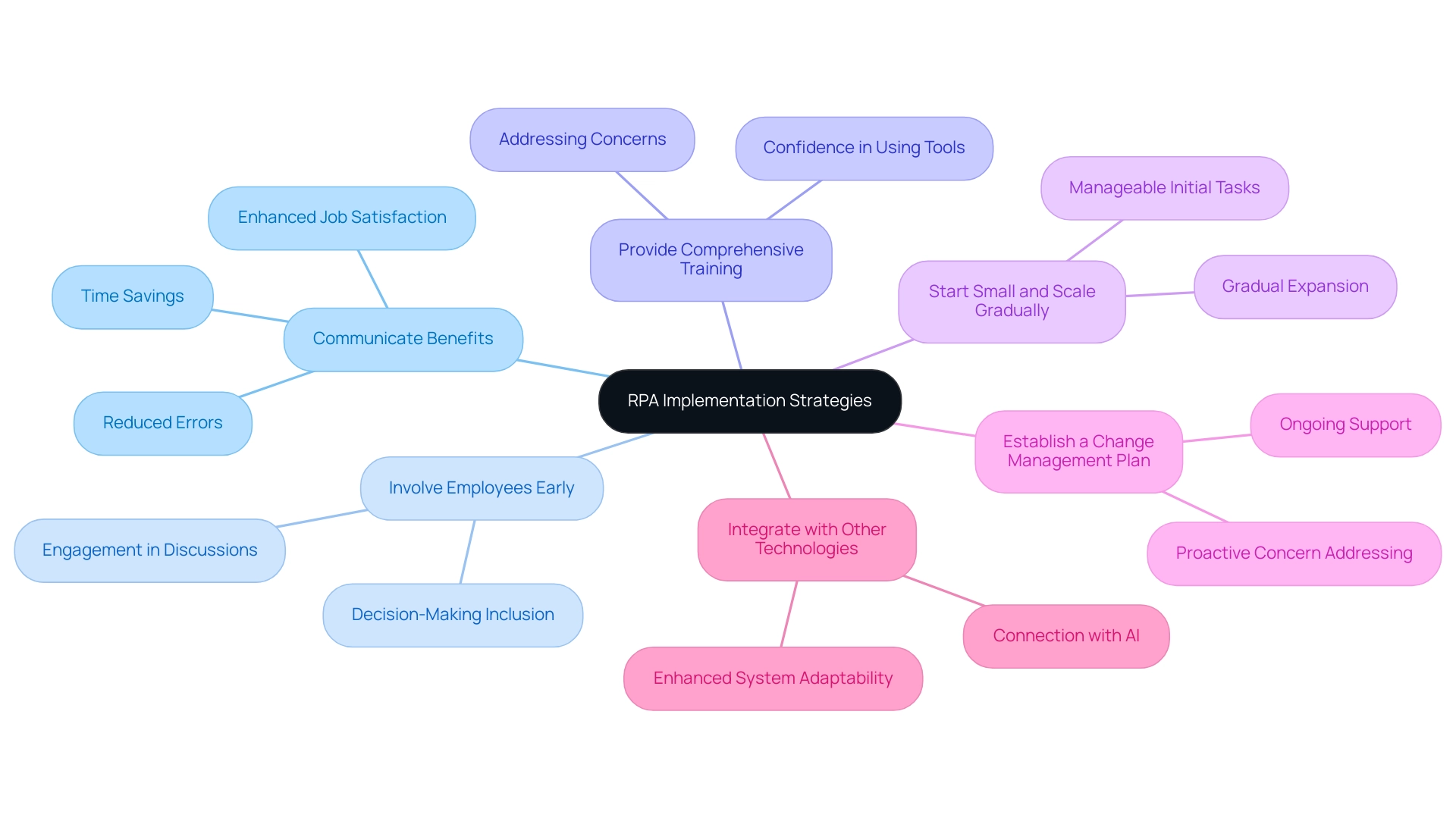
Conclusion
Embracing Robotic Process Automation (RPA) is a transformative step towards achieving operational efficiency in the modern business landscape. With tools like EMMA RPA and Microsoft Power Automate, organizations can tackle repetitive tasks, reduce errors, and ultimately enhance employee satisfaction. The strategic evaluation of these tools allows businesses to select solutions that align with their specific goals, ensuring a tailored approach to automation.
To maximize productivity gains, organizations should focus on:
- Identifying high-impact processes
- Setting clear objectives
- Training employees
- Fostering cross-departmental collaboration
By continuously monitoring and optimizing RPA implementations, businesses can unlock their full potential, driving efficiency and innovation throughout their operations.
Moreover, effective integration of RPA with existing systems is crucial for seamless operations. Conducting system audits, ensuring compatibility, and leveraging APIs can facilitate this integration, allowing organizations to streamline workflows and enhance performance. Regular measurement of key performance indicators will provide valuable insights into the effectiveness of RPA initiatives, ensuring that automation delivers tangible benefits.
Overcoming common challenges in RPA implementation requires a proactive approach that includes:
- Communication
- Employee involvement
- Comprehensive training
By addressing these hurdles, organizations can cultivate a supportive environment that embraces automation as a means to enhance operational success and employee morale.
In a rapidly evolving technological landscape, the adoption of RPA is not just advantageous; it is essential for organizations aiming to thrive. By harnessing the power of automation, businesses can position themselves at the forefront of innovation and efficiency, ultimately achieving their operational goals and fostering a culture of continuous improvement.

